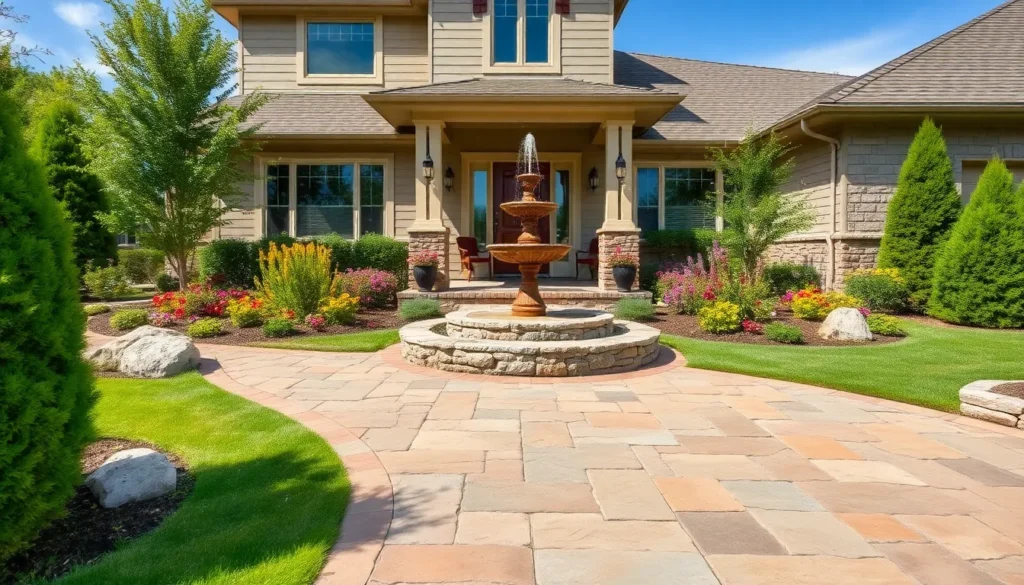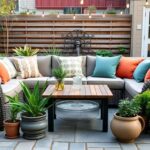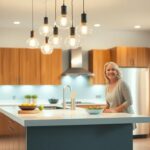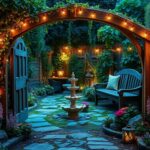We’ve all driven past that one home in the neighborhood that makes us slow down and stare. You know the one – it’s got perfectly placed stone pathways, elegant retaining walls, and hardscape features that transform an ordinary front yard into something extraordinary. That’s the power of thoughtful hardscape design.
Creating stunning outdoor spaces doesn’t require a massive budget or professional landscaping crew. With the right hardscape elements, we can dramatically boost our home’s curb appeal while reducing maintenance time. From decorative concrete walkways to natural stone borders, hardscaping offers endless possibilities to express our personal style.
The best part? These improvements aren’t just beautiful – they’re practical investments that increase property value and create functional outdoor living spaces our families will enjoy for years to come. Let’s explore how strategic hardscape choices can transform your front yard into the neighborhood showstopper.
Define Your Front Yard’s Purpose and Style
Before selecting hardscape materials and layouts, we must establish clear goals for our front yard transformation. This foundational step ensures every design choice aligns with our exact needs and preferences.
Assess Your Space and Budget
Measure your front yard dimensions to determine available space for hardscape features. We recommend documenting the square footage of each potential area, including walkways, flower bed borders, and entertainment zones. Most front yards range from 1,000 to 3,000 square feet, giving us multiple options for hardscape placement.
Calculate your total project budget by allocating 60% for materials, 30% for labor, and 10% for unexpected expenses. Basic hardscape projects typically cost $3,000 to $8,000, while extensive renovations can reach $15,000 to $25,000. We suggest starting with smaller focal points like pathway borders or planter walls if working with limited funds.
Evaluate existing industry elements that we’ll need to work around or incorporate into our design. Mature trees, utility lines, and drainage patterns all influence hardscape placement and material choices. These existing features often become natural anchor points for our new design elements.
Choose a Design Theme That Complements Your Home
Match your hardscape style to your home’s architectural period for the most cohesive appearance. Colonial homes pair beautifully with brick walkways and formal stone borders, while ranch style houses complement natural flagstone and rustic timber accents. Modern homes benefit from clean lines using concrete pavers and steel planters.
Consider your neighborhood’s overall aesthetic when selecting materials and colors. We want our front yard to stand out positively while respecting the surrounding homes’ character. Surveying nearby properties helps us identify popular color palettes and material choices that work well in our exact area.
Select a primary material that becomes your design foundation throughout the project. Natural stone creates timeless elegance, while concrete offers versatility and affordability. Brick provides classic charm, and composite materials deliver low maintenance options with consistent appearance.
Consider Maintenance Requirements
Evaluate your available time for ongoing upkeep when choosing hardscape materials and designs. Natural stone requires periodic sealing every 2 to 3 years, while concrete pavers need occasional pressure washing and joint sand replacement. We recommend selecting materials that match our realistic maintenance commitment.
Factor in seasonal care needs exact to your climate zone. Northern regions require materials that withstand freeze thaw cycles, while southern areas need hardscapes that resist heat damage and UV fading. Salt resistant materials become essential in coastal locations or areas with winter road treatments.
Plan for long term durability by investing in quality materials and proper installation techniques. Well installed hardscapes typically last 15 to 25 years with minimal maintenance, making them cost effective compared to annual landscaping expenses. We suggest prioritizing professional installation for structural elements like retaining walls and drainage systems.
Create an Inviting Entrance with Hardscape Walkways
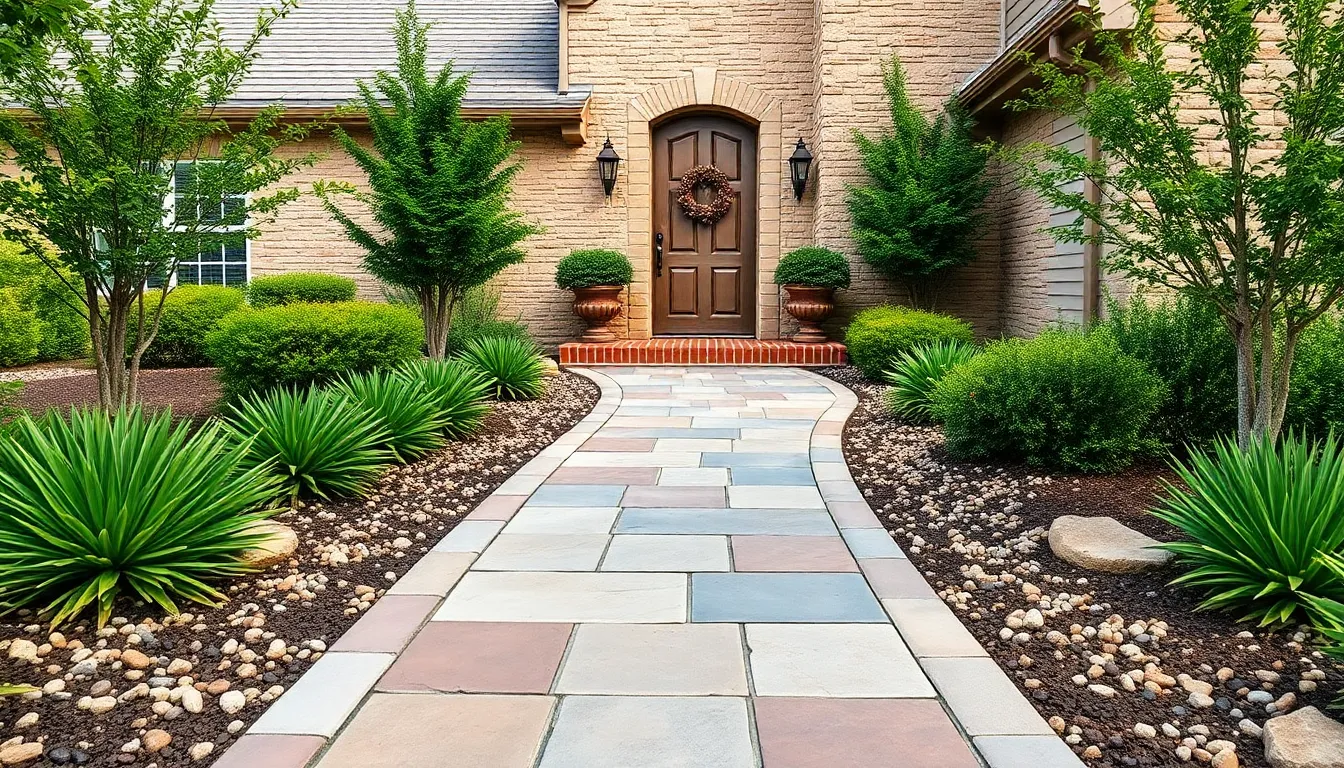
Well-designed walkways serve as the foundation for an impressive front entrance that guides visitors while adding substantial curb appeal. We’ll explore three distinct approaches that transform ordinary pathways into stunning focal points.
Install Natural Stone Pathways
Natural stone walkways provide a timeless elegance that instantly elevates your home’s exterior appearance. Flagstone, slate, and bluestone materials offer unique textures and earthy tones that create organic visual interest. These stones can be arranged in both geometric patterns for formal landscapes or irregular layouts for a more natural aesthetic.
Surrounding stone paths with landscaping pebbles or carefully selected plants helps integrate the hardscape into your yard’s existing design. Contrasting colors and textures between the stone and surrounding elements add visual depth that draws the eye naturally toward your entrance. We recommend choosing stones that complement your home’s exterior materials to maintain design cohesion throughout the property.
Design Brick or Paver Walkways
Brick and paver walkways offer exceptional versatility for both traditional and contemporary front yard designs. Classic brick materials provide warm, reddish hues that can be arranged in popular patterns like herringbone or basket weave configurations. These timeless layouts create visual movement that guides visitors naturally toward your front door.
Pavers expand your design possibilities with various colors, sizes, and shapes that allow complete customization of your pathway’s appearance. Combining different materials such as pavers with concrete or gravel helps fill larger areas effectively while creating distinct focal points at your entrance. We’ve found that mixing materials strategically can reduce costs while maintaining high visual impact.
Add Decorative Stepping Stones
Stepping stones create informal pathways that break up hardscape areas visually while establishing playful, whimsical routes to your entrance. These decorative elements can be crafted from concrete, natural stone, or custom sculpted designs that reflect your personal style preferences. We recommend spacing them at comfortable walking intervals to ensure both safety and aesthetic appeal.
Placing stepping stones amid grass, mulch, or gravel creates a softer overall appearance that blends hardscape elements seamlessly with surrounding landscaping. This approach works particularly well in garden areas where you want to maintain a more organic feel while still providing clear directional guidance. Consider incorporating stones with different textures or subtle color variations to add visual interest without overwhelming the space.
Build Stunning Retaining Walls for Function and Beauty
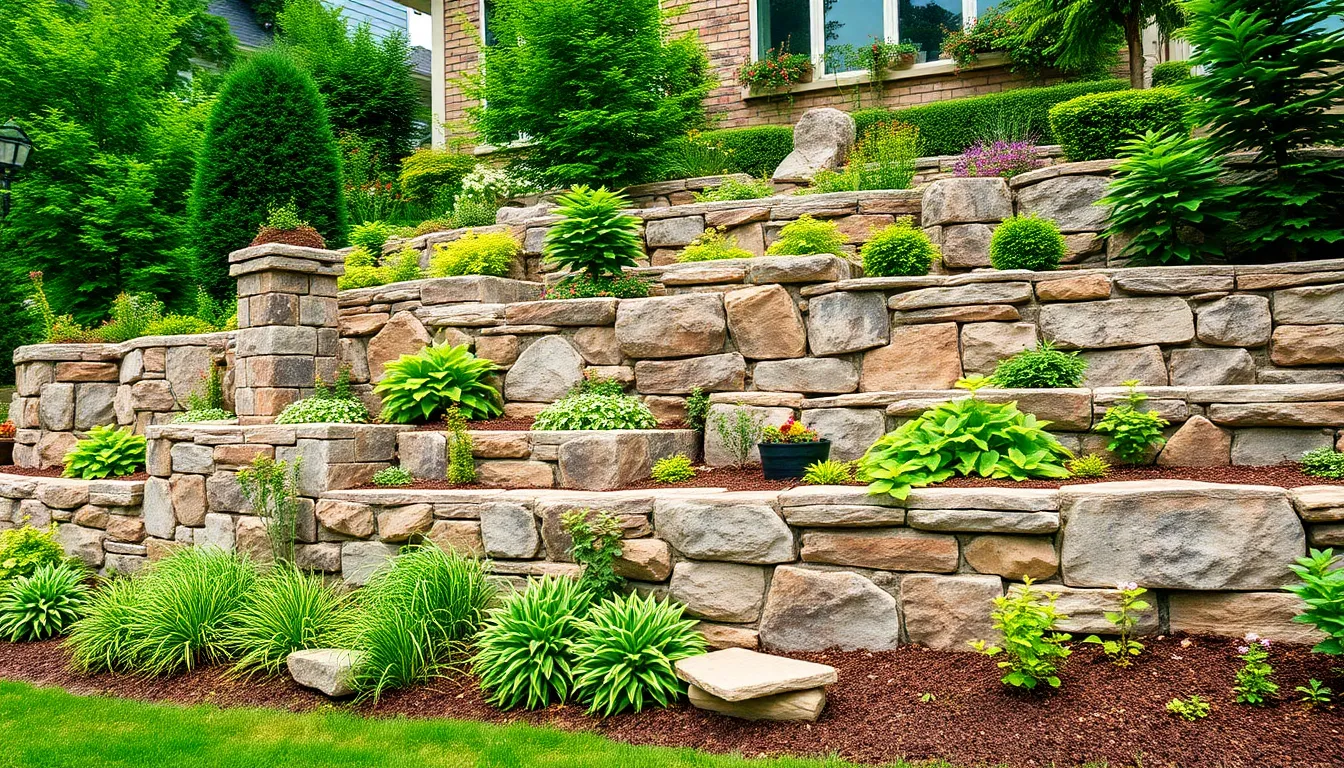
Retaining walls transform challenging terrain while adding architectural interest to your front yard. They solve practical problems like soil erosion and slope management while creating beautiful focal points that enhance your home’s curb appeal.
Construct Natural Stone Retaining Walls
Natural stone walls deliver timeless elegance with their organic textures and unique color variations. Flagstone, limestone, and sandstone offer excellent options depending on your regional availability and budget preferences. These materials blend seamlessly with surrounding plantings and complement various architectural styles from traditional to contemporary.
Stone retaining walls require minimal maintenance once properly installed, making them a smart long term investment. They develop character over time as weather naturally enhances their appearance. We recommend choosing locally sourced stone to reduce costs and ensure the material suits your climate conditions.
Installation involves creating a solid foundation and carefully fitting stones together for stability. The irregular shapes and natural variations in stone create visual interest while providing excellent drainage between joints.
Install Concrete Block Systems
Concrete block systems provide modern functionality with clean architectural lines. These engineered answers handle greater heights and structural demands than natural stone options. We can customize them with various finishes, colors, and textures to match your home’s exterior design.
Modern concrete blocks often include integrated drainage systems that prevent water buildup behind the wall. Many systems allow for creative additions like built in planters, seating areas, or lighting fixtures. Installation typically progresses faster than natural stone since blocks are manufactured to consistent dimensions.
Concrete blocks excel in situations requiring important height or structural strength. They work particularly well for contemporary and modern home styles where clean lines and geometric forms enhance the overall design aesthetic.
Design Terraced Garden Walls
Terraced walls maximize usable space on sloped properties by creating multiple level planting areas. This approach transforms steep, unusable terrain into functional garden beds, lawn areas, or outdoor living spaces. Each terrace provides flat space for different industry uses while improving soil retention and water management.
We can construct terraced systems using either natural stone or concrete blocks depending on your style preferences and budget. Stone terraces offer rustic charm while concrete provides precise geometric lines. Both materials allow for creative planting schemes and integrated hardscape features.
Terraced designs work especially well when combined with pathways, stairs, and strategic lighting. They create visual depth and dimension while solving practical drainage challenges. The stepped appearance adds architectural interest that enhances your front yard’s overall composition and functionality.
Design Eye-Catching Driveways That Make a Statement
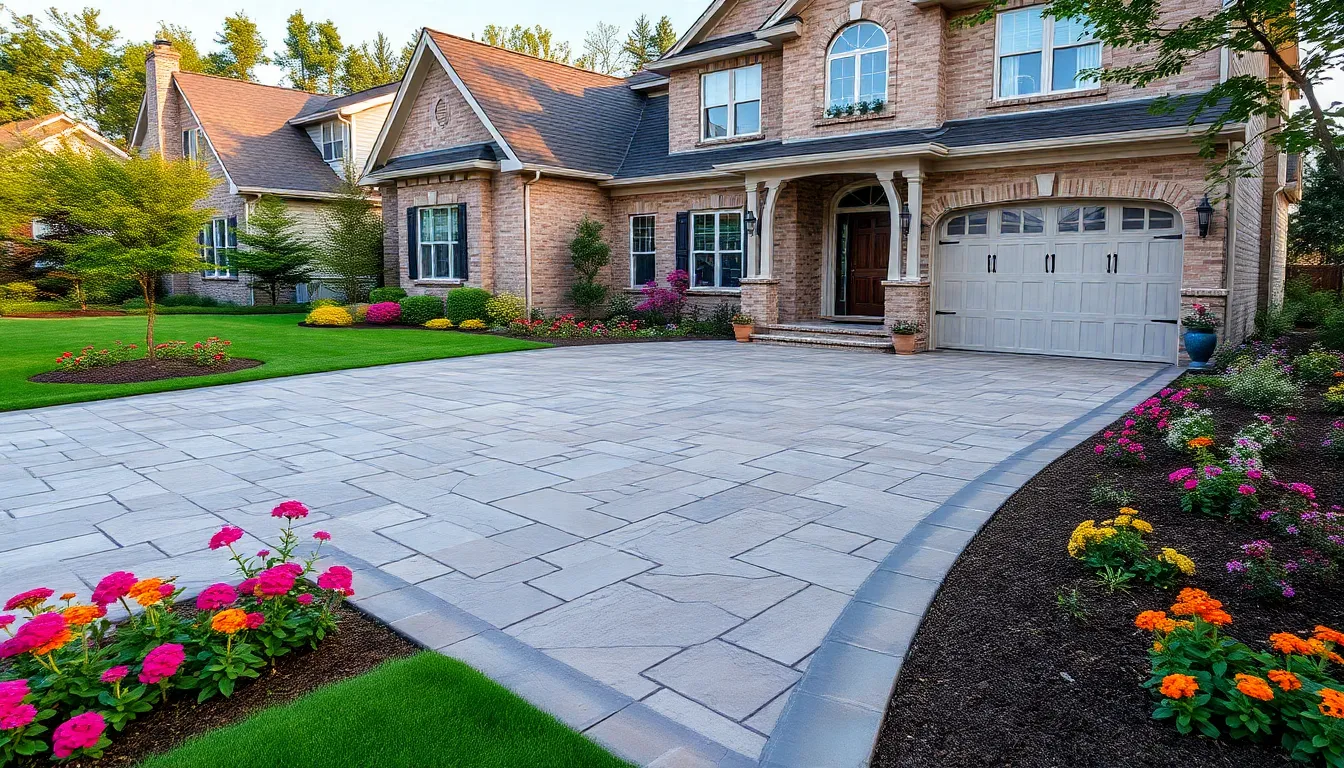
Your driveway serves as the primary pathway to your home and creates the first impression for visitors and passersby. Transform this essential feature into a stunning focal point that enhances your property’s curb appeal and complements your overall hardscape design.
Choose Decorative Concrete Options
Decorative concrete transforms plain surfaces into sophisticated features that rival more expensive materials. Stamping techniques create realistic patterns that mimic natural stone, brick, or tile while maintaining concrete’s durability and cost effectiveness. Staining adds rich colors and depth to concrete surfaces, allowing you to match your home’s exterior palette or create striking contrasts. Exposed aggregate finishes reveal beautiful stones and pebbles within the concrete, providing texture and visual interest that works especially well in natural settings.
These decorative techniques offer long term value since concrete requires minimal maintenance compared to other driveway materials. Color options range from subtle earth tones to bold statement hues, giving you flexibility to create either understated elegance or dramatic impact. Installation costs typically fall between standard concrete and premium paving materials, making decorative concrete an excellent middle ground option for budget conscious homeowners.
Install Interlocking Paver Driveways
Interlocking pavers provide superior drainage and repair advantages over traditional concrete surfaces. These versatile materials come in many shapes, colors, and sizes that allow for custom patterns matching your home’s architectural style. Herringbone patterns create classic appeal, while running bond layouts offer clean, contemporary lines that complement modern homes.
Pavers distribute weight more effectively than solid concrete, reducing cracking and settlement issues common in traditional driveways. Individual units can be easily replaced if damaged, eliminating the need for costly section repairs that concrete often requires. Installation involves careful base preparation and sand leveling, but the modular system allows for precise fitting around curves, slopes, and industry features.
Color coordination with your home’s exterior creates cohesive design flow that enhances overall curb appeal. Consider mixing complementary shades or incorporating border accents that tie into your walkway or entrance materials for a unified hardscape appearance.
Create Gravel and Stone Combinations
Gravel offers cost effective coverage for large driveway areas while providing excellent drainage properties. Crushed granite, pea gravel, and decorative stones each deliver different textures and colors that can complement your industry design. Larger stones work well as borders or accent features, creating defined edges and visual interest along driveway perimeters.
Layering different materials thoughtfully maintains design cohesion while adding depth and character to your front yard hardscape. Stone borders contain loose gravel effectively while creating clean transition lines between your driveway and surrounding landscaping. Consider incorporating stepping stones or concrete strips within gravel areas to provide stable walking surfaces and reduce maintenance.
Maintenance requirements vary by gravel type, with smaller stones needing periodic replenishment and larger decorative rocks requiring occasional repositioning. Proper base preparation and edging installation ensure longevity and reduce ongoing upkeep needs while maintaining your driveway’s attractive appearance.
Incorporate Water Features for Tranquil Appeal
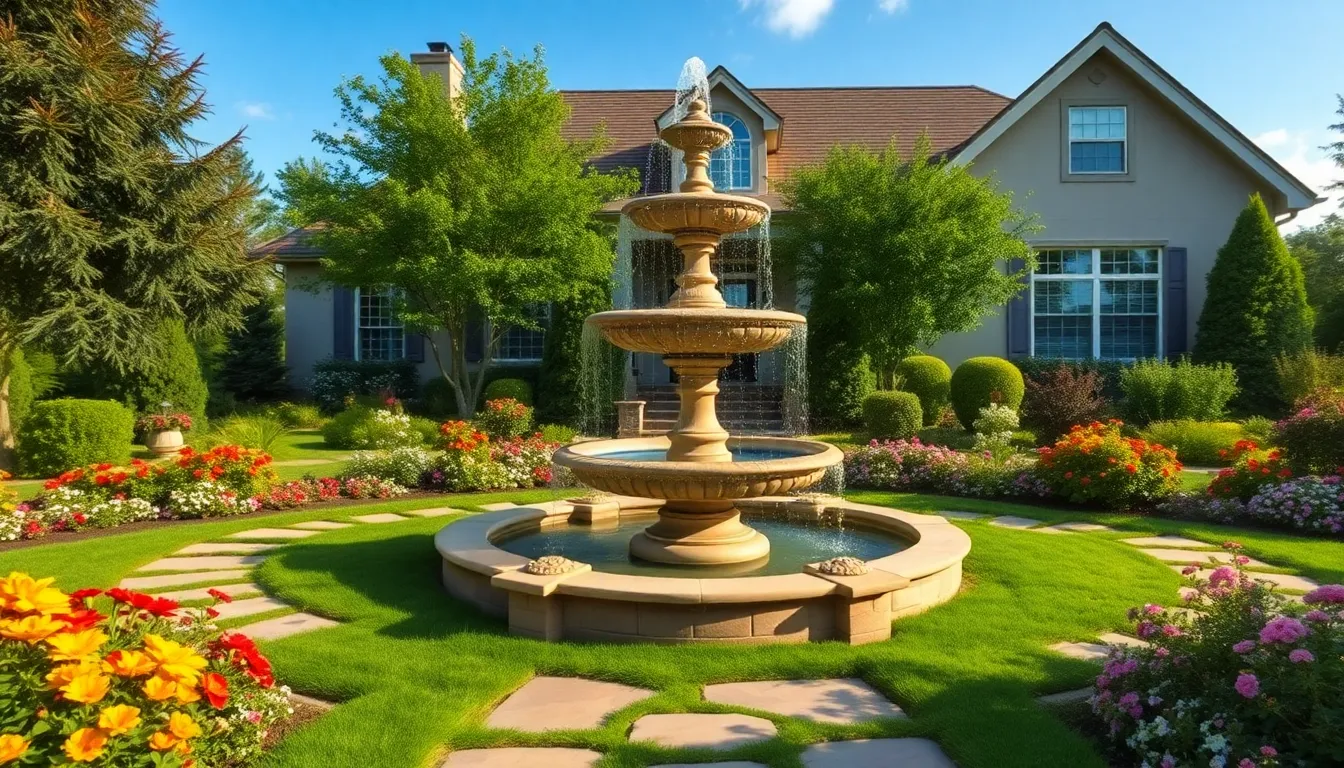
Adding water features to your front yard hardscape creates an oasis of calm while boosting your home’s curb appeal. These elements transform ordinary spaces into serene retreats that welcome guests with soothing sounds and visual beauty.
Install Fountain Centerpieces
Fountains serve as stunning focal points that anchor your entire front yard design with elegance and sophistication. Classic tiered garden fountains create cascading water sounds that provide a peaceful atmosphere throughout the day. We recommend considering designs like the Williamsburg Pineapple 2-Tier Fountain, which symbolizes hospitality with its welcoming pineapple shape, or the Caterina Tiered Fountain that offers multiple cascading levels perfect for traditional gardens.
Position your fountain strategically where it’s visible from inside your home to maximize year-round enjoyment and curb appeal. Integrate fountains with mixed materials such as concrete pavers, natural stones, and wood accents to add texture and visual interest to your industry design. These combinations create depth while maintaining a cohesive look that complements your home’s architecture.
Choose fountain styles that align with your overall design theme to ensure seamless integration with existing hardscape elements. Materials and designs should reflect your home’s architectural style for maximum visual impact and property value enhancement.
Build Pond and Stream Elements
Ponds and streams introduce naturalistic water features that enhance your front yard’s serenity while attracting beneficial wildlife. Design a palmless waterfall or freshwater pond with flowing streams to create soft, relaxing sounds that mask neighborhood noise. These elements require careful layout planning to blend seamlessly with your existing industry shapes and elevations.
Natural materials work best for mimicking organic water flow patterns and creating realistic depth variations. Stone placement and stream routing should follow natural water movement principles to achieve an authentic appearance. We suggest using native rocks and boulders to frame pond edges and create natural-looking water transitions.
Wildlife attraction becomes an added benefit when you incorporate pond and stream elements into your hardscape design. Birds, butterflies, and beneficial insects will naturally gravitate toward these water sources, creating a living network in your front yard.
Add Wall-Mounted Water Features
Wall-mounted water features provide compact answers for smaller front yards or areas where space conservation is essential. These modern alternatives work by circulating water over mounted surfaces, creating continuous gentle movement without requiring extensive ground space. They maintain the soothing auditory effects of flowing water while adding sleek aesthetic appeal.
Installation versatility makes wall-mounted features ideal for complementing existing hardscape elements like retaining walls or garden boundaries. Water circulation systems can be easily integrated into existing structures, making them perfect retrofit options for established landscapes.
Space efficiency allows creative placement on exterior walls, privacy screens, or standalone structures throughout your front yard. These features add vertical interest while maintaining clean lines that work well with contemporary and traditional home styles alike.
Establish Outdoor Living Spaces in Your Front Yard

Transforming your front yard into a functional outdoor living space extends your home’s usable area while dramatically boosting curb appeal. We’ll explore three essential hardscape elements that create inviting spaces where you and your guests can relax and gather.
Create Welcoming Seating Areas
Build comfortable patio spaces using durable pavers or natural stone flooring that can withstand weather while maintaining visual appeal. These seating areas work perfectly as extensions of your porch or as standalone relaxation zones positioned strategically throughout your front yard industry.
Select outdoor furniture that complements your hardscape materials and provides genuine comfort for reading, conversation, or simply enjoying your outdoor space. Weather resistant pieces in neutral tones blend seamlessly with stone and paver installations.
Incorporate surrounding planters filled with seasonal flowers or evergreen shrubs to soften the hardscape edges and create a peaceful atmosphere. Plants frame your seating area naturally while adding color and texture that changes throughout the year.
Position seating areas where they’ll receive optimal lighting conditions and offer pleasant views of your industry or neighborhood. Strategic placement ensures these spaces become practical gathering spots rather than decorative afterthoughts.
Build Fire Pit Gathering Spaces
Install fire pit areas as focal points that extend your outdoor living season and create natural gathering spaces for family and friends. Fire pits integrate beautifully into existing patio hardscapes or can anchor new outdoor living zones.
Choose appropriate materials like natural stone rings or metal fire bowls that complement your overall hardscape design palette. Stone surrounds blend organically with paver patios while modern metal options create striking contemporary statements.
Design seating arrangements in circular or semicircular patterns around your fire pit to encourage conversation and ensure everyone enjoys equal warmth and visibility. Built in stone benches or movable outdoor furniture both work effectively.
Add landscaping elements like decorative pebbles or ornamental grasses around the fire pit area to create visual interest and help integrate the feature with your broader yard design. These natural materials soften hardscape edges while maintaining the space’s functionality.
Design Pergola and Gazebo Structures
Create vertical interest with pergolas that define exact areas within your front yard hardscape while providing partial shade and architectural appeal. These structures transform flat patio spaces into ever-changing outdoor rooms with clear purpose and function.
Select construction materials like cedar wood for natural warmth or powder coated metal for modern durability that matches your home’s exterior style. Quality materials ensure your structure enhances rather than detracts from your property’s overall aesthetic.
Define functional zones beneath pergolas and gazebos by installing comfortable seating, dining areas, or even outdoor workspaces that take advantage of the shelter these structures provide. Clear zoning makes your front yard more purposeful and inviting.
Integrate lighting elements within pergola beams or gazebo frameworks to extend usability into evening hours while creating ambient atmosphere. String lights, lanterns, or built in fixtures all contribute to the space’s functionality and appeal.
Plan for climbing plants on pergola structures to create natural shade over time while adding seasonal color and texture. Vines like clematis or climbing roses enhance the structure’s beauty while providing practical benefits like increased privacy and cooling.
Add Functional Storage and Privacy Solutions

Smart hardscape design transforms your front yard into a functional sanctuary that cleverly combines storage with privacy elements. We’ll explore three strategic approaches that maximize space utility while maintaining curb appeal.
Install Decorative Fence Systems
Decorative fences serve both aesthetic and practical purposes in front yard hardscaping. These versatile structures define property boundaries while adding architectural interest and essential privacy to your outdoor space. Materials like wood, wrought iron, composite materials, stone, or brick walls with ornamental details offer distinct design possibilities that complement your home’s facade.
Creating a cohesive look requires designing fences that harmonize with existing hardscape materials throughout your yard. Fence systems can include integrated gates and lighting fixtures for added functionality and welcoming ambiance. Well-planned fence installations provide the foundation for layering additional privacy elements like climbing plants or decorative screens.
Build Integrated Planter Walls
Planter walls are multifunctional hardscape features that combine greenery with structural support. These integrated elements can be constructed from stone, brick, or concrete materials, serving dual purposes as retaining walls or property borders while providing dedicated planting space. This fusion approach softens harsh hardscape lines and enhances visual interest through natural plant elements.
Designing planter walls at varying heights creates privacy screening opportunities while offering convenient seating areas for outdoor relaxation. Strategic placement of these structures maximizes your yard’s functional space by creating distinct zones for different activities. Integrated planter walls work exceptionally well when coordinated with other hardscape elements like walkways and patio areas.
Create Hidden Utility Areas
Hardscaping can cleverly conceal necessary but unsightly utility areas throughout your front yard. Dedicated enclosures built within retaining walls or positioned behind planter walls effectively hide trash bins, HVAC units, and irrigation controls from view. Using coordinated doors, gates, or lattice screens that match your existing hardscape ensures these utility areas blend seamlessly into the overall design.
This strategic concealment approach dramatically improves your yard’s overall neatness and aesthetic appeal while maintaining easy accessibility for maintenance needs. Thoughtful utility area planning prevents these necessary elements from detracting from your carefully crafted outdoor spaces. Combining materials and textures with your home’s exterior colors creates a polished, professional appearance that enhances property value.
Enhance With Lighting and Finishing Touches
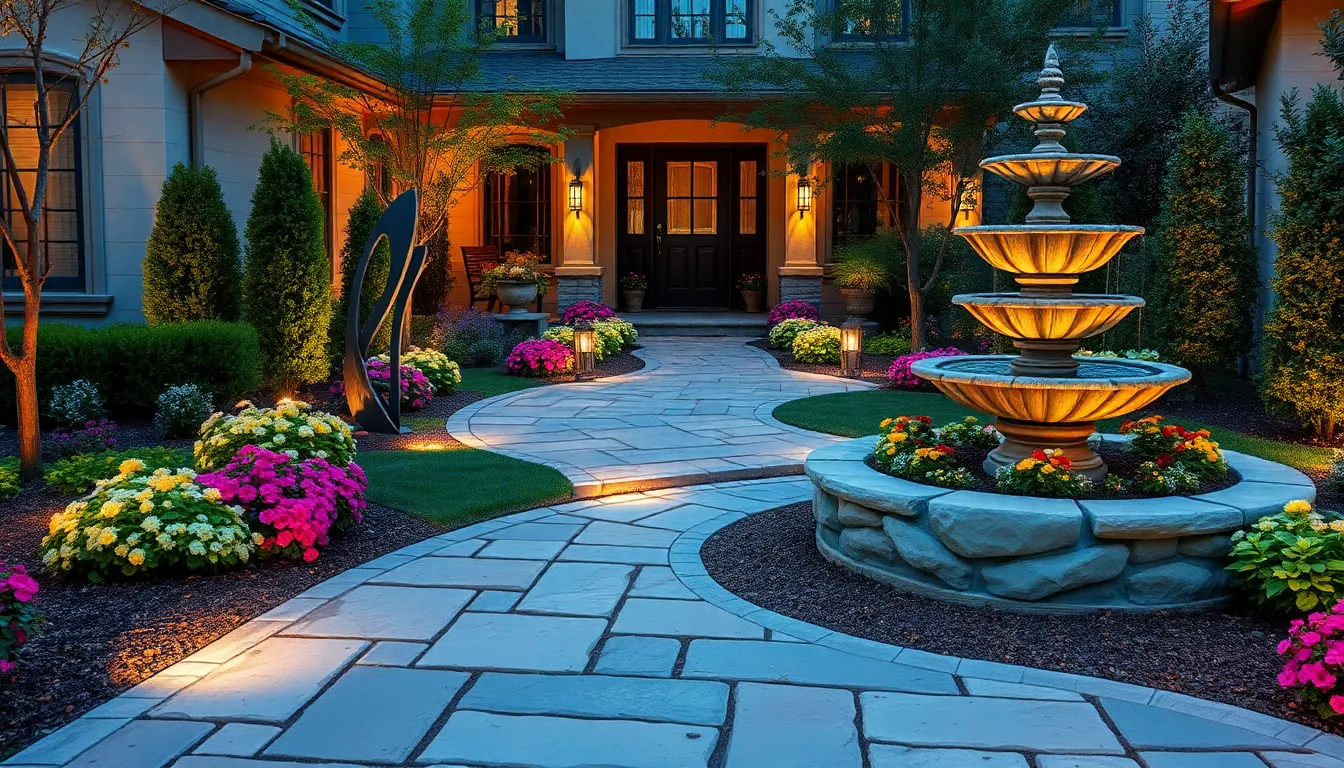
Thoughtful lighting and decorative elements transform hardscape features from simple structures into captivating focal points that extend your outdoor enjoyment well into the evening hours.
Install Pathway and Accent Lighting
Pathway lighting guides visitors safely while creating stunning visual appeal. LED fixtures along walkways illuminate stone pathways and paver installations, ensuring safe navigation during evening hours. Solar-powered options offer energy-efficient answers that automatically activate at dusk, requiring minimal maintenance throughout the year.
Accent lighting highlights architectural details and hardscape features. Spotlights positioned at strategic angles can emphasize retaining walls, water features, and sculptural elements, creating dramatic shadows and depth. Uplighting beneath trees or pergolas adds dimension to outdoor living spaces, while downlighting from overhead structures provides gentle ambient illumination.
Strategic placement maximizes both functionality and ambiance. Position lights every 6-8 feet along pathways to ensure consistent illumination without creating harsh shadows. Accent fixtures should be placed 2-3 feet from targeted features to achieve optimal highlighting effects while avoiding glare.
Add Decorative Planters and Urns
Decorative planters soften hardscape surfaces while introducing color and texture. Large ceramic urns flanking entrance pathways create symmetrical elegance that complements stone walkways and concrete features. Rectangular planters integrated into retaining walls provide structured growing spaces that enhance vertical garden designs.
Material selection ensures planters complement existing hardscape elements. Stone planters match natural stone retaining walls and pathways, creating cohesive design flow throughout the front yard. Metal containers offer modern contrast against traditional brick and paver installations, while terra cotta options provide warm earth tones that harmonize with gravel surfaces.
Seasonal plantings keep displays fresh and captivating year-round. Spring bulbs in decorative urns welcome visitors with colorful blooms, while summer annuals provide continuous color throughout growing seasons. Fall mums and winter evergreens ensure attractive displays during cooler months, maintaining curb appeal regardless of weather conditions.
Incorporate Artistic Elements and Sculptures
Artistic elements serve as focal points that personalize hardscape designs. Custom stone carvings integrated into retaining walls create unique architectural details that reflect individual style preferences. Metal sculptures positioned near water features or seating areas add contemporary flair while serving as conversation starters.
Fountains combine artistic appeal with soothing water sounds. Tiered stone fountains complement natural stone pathways and create elegant centerpieces for entrance areas. Modern geometric fountains enhance contemporary hardscape designs while providing relaxing background sounds that mask street noise.
Scale and placement ensure artistic elements enhance rather than overwhelm. Sculptures should match the proportions of surrounding hardscape features, with larger pieces reserved for spacious entrance areas and smaller accents used along pathways. Position artistic elements where they can be viewed from multiple angles, creating visual interest from both street and interior perspectives.
Conclusion
We’ve shown you how strategic hardscape design can completely transform your front yard into a stunning and functional outdoor space. From welcoming walkways to elegant retaining walls and tranquil water features these elements work together to create a cohesive design that reflects your personal style.
The key to success lies in careful planning and selecting materials that complement both your home’s architecture and your lifestyle needs. Whether you’re working with a modest budget or planning an extensive renovation these hardscape ideas offer answers for every situation.
Your front yard is more than just a pathway to your door—it’s an opportunity to make a lasting impression while creating valuable outdoor living space. With the right combination of hardscape elements you’ll enjoy increased property value enhanced curb appeal and a beautiful space that welcomes both family and guests for years to come.
Frequently Asked Questions
What is hardscaping and how does it enhance curb appeal?
Hardscaping refers to the non-living elements of landscape design, including stone pathways, retaining walls, patios, and driveways. These features enhance curb appeal by creating structure, defining spaces, and adding visual interest to your front yard. Well-designed hardscaping serves as a practical investment that increases property value while creating functional outdoor living areas that complement your home’s architecture.
How much should I budget for a front yard hardscape project?
Budget requirements vary significantly based on materials, project scope, and whether you hire professionals. Start by measuring your yard and documenting square footage to determine material needs. Natural stone and custom installations typically cost more than concrete pavers or gravel options. Consider both material and labor costs, and remember that quality hardscaping is a long-term investment in your property value.
What are the best materials for walkways and pathways?
Popular walkway materials include natural stone for timeless elegance, brick and pavers for versatility and unique patterns, and decorative stepping stones for informal pathways. Natural stone offers durability and various arrangement options, while brick provides classic appeal. Stepping stones blend seamlessly with landscaping and offer playful design possibilities while providing clear directional guidance to your entrance.
How do retaining walls benefit my front yard design?
Retaining walls serve both functional and aesthetic purposes by preventing soil erosion, creating level planting areas, and adding architectural interest. Natural stone walls offer timeless elegance with minimal maintenance, while concrete block systems provide modern functionality and structural strength. Terraced garden walls maximize usable space on sloped properties and enhance water management capabilities.
What driveway options can improve my home’s curb appeal?
Transform your driveway with decorative concrete that mimics expensive materials, interlocking pavers for superior drainage and repair advantages, or gravel and stone combinations for cost-effective drainage solutions. Decorative concrete offers durability and low maintenance, while pavers provide design flexibility. Gravel options are budget-friendly and can be layered with complementary materials for design cohesion.
How can water features enhance my front yard hardscape?
Water features add tranquility and visual appeal to front yard designs. Fountain centerpieces serve as elegant focal points, while ponds and streams create serene environments that attract wildlife. Wall-mounted water features are perfect for smaller spaces. Strategic placement maximizes visibility and enjoyment, while natural materials ensure authenticity and complement your overall hardscape design.
Can I create outdoor living spaces in my front yard?
Yes, front yard outdoor living spaces extend usable areas and boost curb appeal. Consider comfortable patio seating areas made from durable materials, fire pit gathering spaces as social focal points, and pergola or gazebo structures for defined outdoor zones. These elements create functional sanctuaries while maintaining appropriate privacy and neighborhood aesthetics.
How important is lighting in hardscape design?
Lighting is crucial for both safety and visual appeal in hardscape design. Pathway lighting ensures safe navigation, while accent lighting highlights architectural features and creates ambiance. LED and solar-powered options offer energy efficiency. Strategic placement maximizes functionality during evening hours and extends the usability of your outdoor spaces year-round.
What maintenance considerations should I keep in mind?
Choose hardscape materials that align with your maintenance commitment and local climate conditions. Natural stone requires minimal upkeep, while concrete may need periodic sealing. Consider long-term durability when selecting materials. Plan for seasonal maintenance like cleaning, sealing, and plant care around hardscape features to maintain their appearance and functionality over time.
How do I incorporate decorative elements into my hardscape design?
Enhance hardscape features with decorative planters, artistic sculptures, and seasonal plantings for year-round appeal. Consider scale and placement to ensure elements enhance rather than overwhelm your design. Incorporate climbing plants on pergolas, use containers for flexible planting options, and select artistic elements that complement your home’s architectural style and neighborhood aesthetic.

